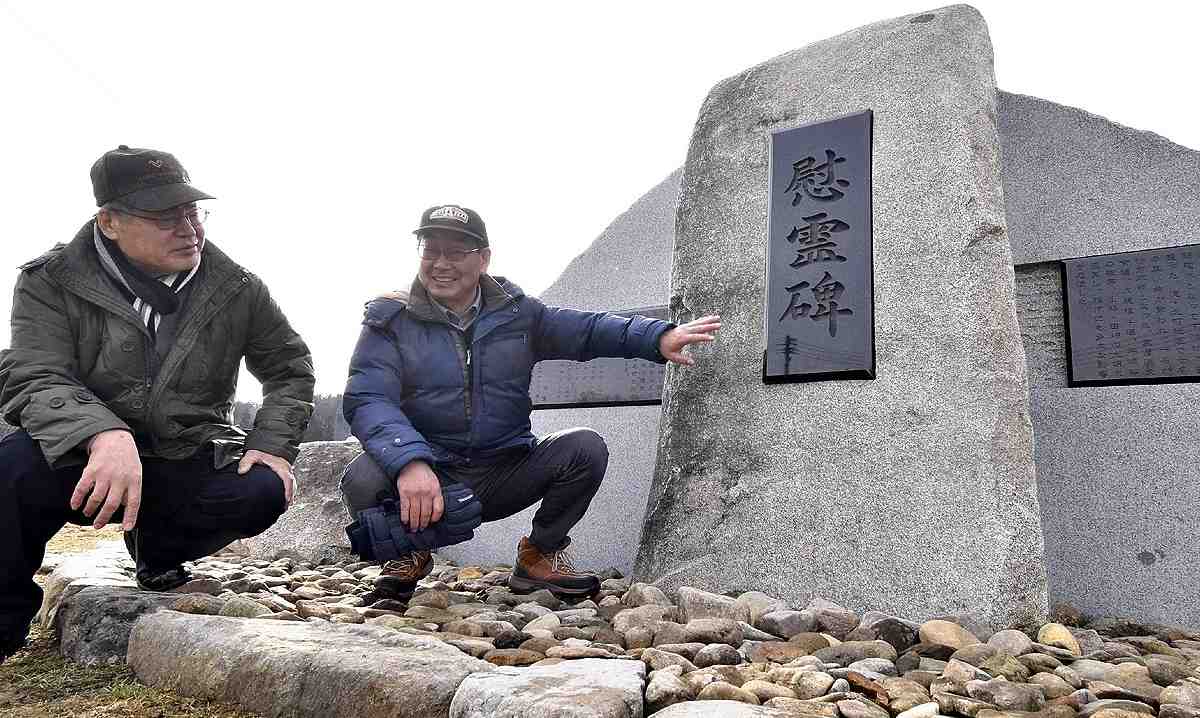
Kiyomichi Mori, left, and Kunihiro Kashimura reflect on their activities in front of a cenotaph in Sukagawa, Fukushima Prefecture, on Jan. 26.
13:58 JST, February 5, 2021
A cenotaph has been erected by bereaved families and affected local residents to remember those who died in the collapse of a dam in the Great East Japan Earthquake in the city of Sukagawa, Fukushima Prefecture. The unveiling ceremony for the cenotaph will be held on March 11, the 10th anniversary of the disaster.
The Fujinuma Dam collapsed due to the earthquake, and local residents in the area were swallowed up by the muddy waters. Eight people were lost that day. Seven of them, aged 14 to 89, were confirmed dead, and a 1-year-old boy was never found.
The dam was built in 1949 to store water for agriculture, creating a reservoir called Lake Fujinuma that could hold 1.5 million tons of water. At the time of the earthquake, the lake was almost full and the sudden flood hit two local communities downstream. Of 131 structures that were flooded, 22 were destroyed or washed away.
The efforts to build the cenotaph were led by Kiyomichi Mori, 64, the chairman of the association of victims of the flood, and Kunihiro Kashimura, 65, the chairman of the working committee to erect the cenotaph.
Mori’s house was washed away by the surge of muddy water, and Kashimura’s house was flooded. Immediately after the disaster, neither of them had time to consider making a record of the devastation because they were busy rebuilding their lives.
But when they learned that it had been difficult to collect testimony and other accounts of the catastrophic 1951 flood from Heiwaike pond in Kyoto Prefecture, they decided to start documenting the disaster.
However, when they proposed to bereaved families and victims the idea of setting up a cenotaph and other activities, those families were similarly too busy rebuilding their houses to listen to the two in detail. Some of them even expressed a refusal to document the tragedy.
Nevertheless, Mori and Kashimura went on explaining the significance of their activities to such people as members of the victims association, friends and acquaintances. And they steadily increased the number of supporters, until they were able to establish the working committee in June 2018.
The cenotaph, which includes stone slabs inscribed with the names of some of the victims, was completed on Jan. 26. Some bereaved families said they could not accept the fact that their family members had passed away, so space for those names was left blank.
In addition to the cenotaph, Mori and Kashimura are working on a pamphlet and a collection of testimonies to convey the reality of the damage. For the pamphlet, they visited residents to collect photos from the time of the disaster and drew a map showing the flooded area. About 3,000 copies of the pamphlet are scheduled to be completed by the middle of this month.
So far, they have interviewed about 20 people about their stories of the disaster, but many others could not be interviewed because remembering was too painful.
Even so, Kashimura was determined. “We can’t stop; the same tragedy must not happen again,” he said.
Mori said: “The torrent of muddy water changed the shape of the land in an instant. I want to convey the horror of the dam’s collapse.”
He died after helping others
The name of Sanzo Ishida, whom the muddy water swept to his death at age 68, is inscribed on the cenotaph.
Ishida was told by a neighboring woman that the flow of water from the reservoir had temporarily stopped. Thinking that it might surge again, Ishida urged the woman to evacuate and helped her to do so, saving the lives of the woman and her parents-in-law.
When Ishida’s sister, Fumiko Soeta, 83, of the village of Tenei, Fukushima Prefecture, entered the area that night, there was no trace of Ishida’s house. The next day, Ishida’s body was found downstream in the river. The neighboring woman said in tears to Soeta, “We are alive because of him.”
Ishida was remembered as honest and devoted to his work. After the end of a company career, he was diagnosed with stomach cancer, but after surgery and drug treatment, he was cured. Ishida and Soeta were relieved to think that a happy life would lie ahead.
“I’m proud of my brother, who acted for others in the middle of confusion,” Soeta recalled. “I will live longer for him and will praise him when I meet him in the afterlife.”
"Society" POPULAR ARTICLE
-

M4.9 Earthquake Hits Tokyo, Neighboring Prefectures
-

Israeli Tourists Refused Accommodation at Hotel in Japan’s Nagano Pref., Prompting Protest by Israeli Embassy and Probe by Prefecture
-

M7.5 Earthquake Hits Northern Japan; Tsunami Waves Observed in Hokkaido, Aomori and Iwate Prefectures
-

Tsukiji Market Urges Tourists to Avoid Visiting in Year-End
-

M5.7 Earthquake Hits Japan’s Kumamoto Pref., Measuring Upper 5 Intensity, No Tsunami Expected
JN ACCESS RANKING
-

Tokyo Economic Security Forum to Hold Inaugural Meeting Amid Tense Global Environment
-

Keidanren Chairman Yoshinobu Tsutsui Visits Kashiwazaki-Kariwa Nuclear Power Plant; Inspects New Emergency Safety System
-

Imports of Rare Earths from China Facing Delays, May Be Caused by Deterioration of Japan-China Relations
-

University of Tokyo Professor Discusses Japanese Economic Security in Interview Ahead of Forum
-

Japan Pulls out of Vietnam Nuclear Project, Complicating Hanoi’s Power Plans






















